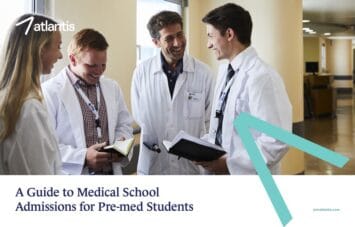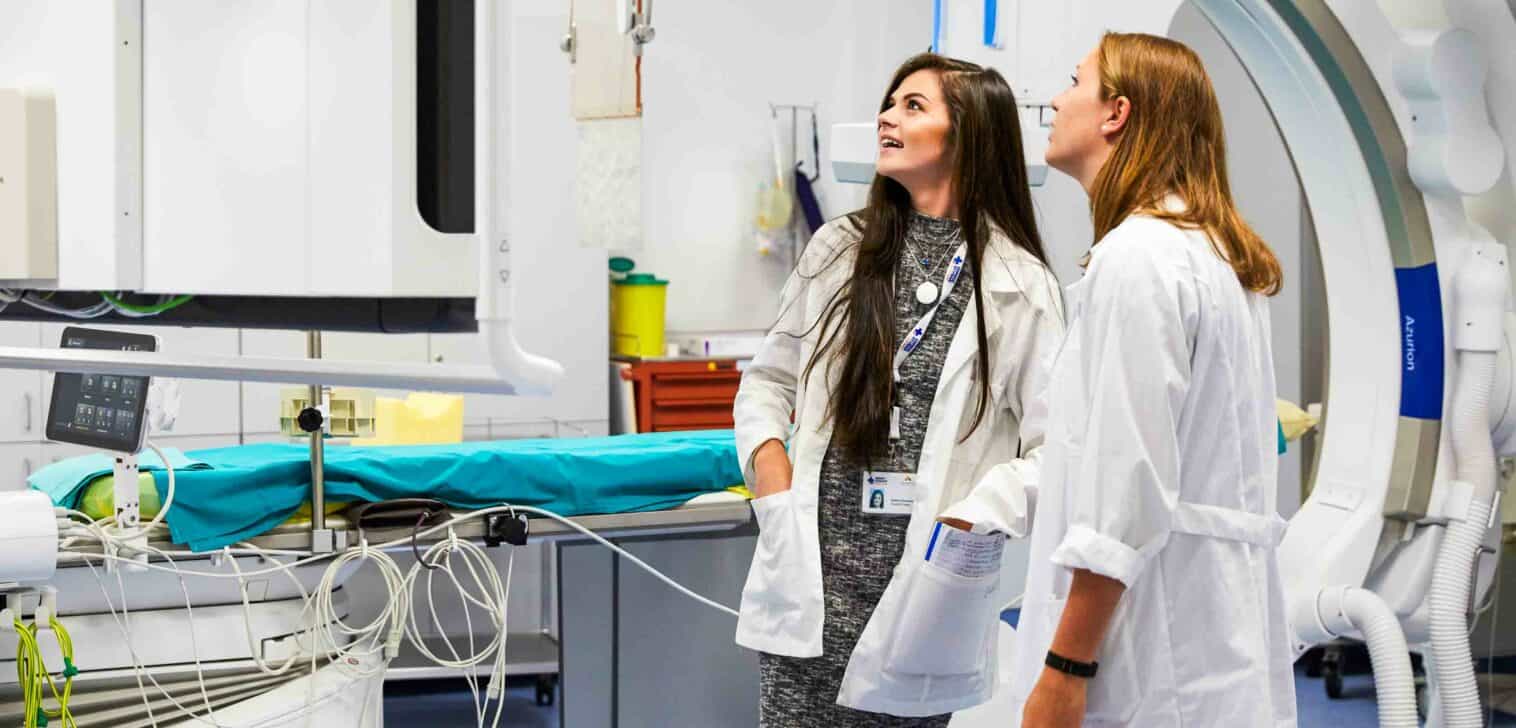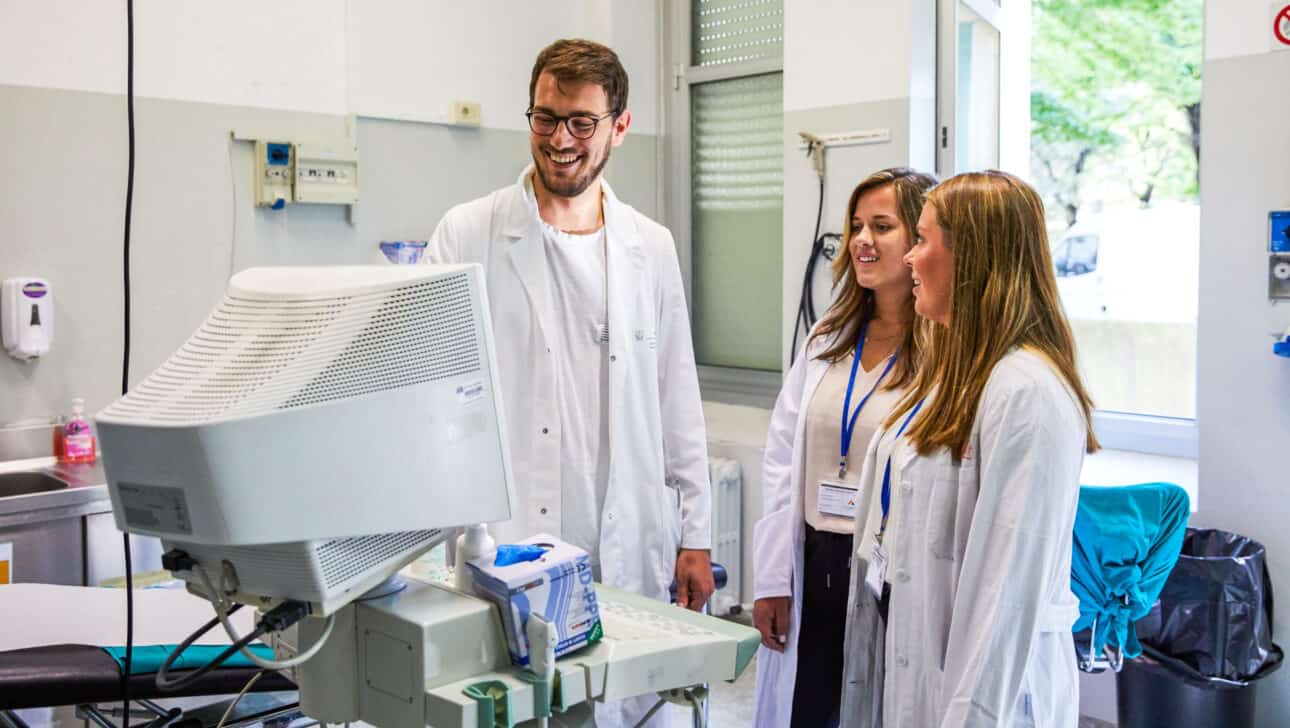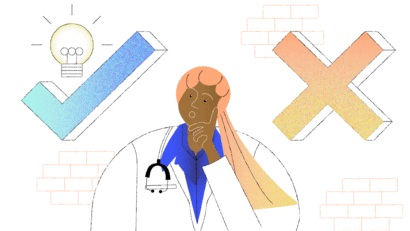
Applying to Med/PA School
Understanding PSLF (Public Service Loan Forgiveness)

About Dr. Jake Groenendyk
Dr. Jake Groenendyk is a native of Sioux Center, Iowa. He attended Covenant College in Lookout Mountain, Georgia, and graduated with a B.A. in Biology, followed by an M.D. from Washington University in St. Louis. He is now an internal medicine resident at Northwestern University, and in his free time enjoys reading, running, and cycling.
What kind of debt can you expect from medical school?
Student loans are a big concern for many prospective medical students. In 2018, the American Association of Medical Colleges (AAMC) estimated that 75% of graduating students had educational debt, with a median loan burden of $200,000 for those that took out loans. While financial considerations shouldn’t be the primary driver of your decision to become a physician, anyone considering a career in medicine should understand the basics of financing a medical education. The bottom line is, before understanding loan forgiveness, you should first know the reality of medical school debt.
This post will focus on one of the most popular and well-known (but often poorly understood) programs for student loan management, Public Service Loan Forgiveness (PSLF). PSLF offers a tantalizing promise: tax-free forgiveness of student loans after ten years of qualifying payments. For some borrowers, this can entail forgiveness of hundreds of thousands of dollars of debt. However, only a few people have successfully received loan forgiveness through PSLF so far, and many observers think the program is unlikely to survive for very long. Here is what this article will cover:
-
What do you need to know about PSLF?
-
Is it likely that current medical students will ever see any forgiveness through PSLF?
-
Is PSLF a good fit for you?
What is PSLF?
In addition to the available options for avoiding heavy student loan debt during medical school, future physicians who are interested in working for nonprofits can consider using the Public Service Loan Forgiveness (PSLF) program to decrease their educational debt burden. PSLF was created in 2007 to encourage people with high levels of educational debt to consider the nonprofit track. The program is structured to forgive any remaining federal loan debt after a borrower has made 120 eligible payments. These are payments that were required to be made while the borrower was employed by the federal government or an eligible nonprofit. “Required” payments are the regular monthly payments on your loan; they cannot be made during a grace period. (Thus, it would not count to simply make a new payment every day for 120 days and consider those the 120 payments.)
Many academic hospitals, which train residents, are considered 501(c)3 nonprofits, and thus physicians can begin their careers with 3-7 years of eligible payments. It’s also important to note that this program will only repay qualifying federal loans; this category does not include federal Perkins loans (which have a separate repayment program, but can become eligible through loan consolidation) or loans from your university or a private corporation (which cannot become eligible through consolidation).
Loan forgiveness after 10 years might not seem like much, since the standard repayment plan splits a borrower’s loan burden into 120 equal payments spread over 10 years ($3000 monthly on a $200,000 loan that the borrower begins paying off after residency). However, many students opt for one of the federal government’s income-based repayment plans, such as Pay As You Earn (PAYE) or Revised Pay As You Earn (REPAYE), which bases the monthly payments on the borrower’s expected discretionary income.
These payments are typically a more manageable $320-$360 for a single resident with no dependents. This could result in tax-free loan forgiveness of over $200,000 for some residents. For most borrowers, this is far more attractive than the income-based forgiveness program, which forgives any remaining federal loan balance after 20-25 years (depending on which payment plan you choose) of eligible payments. Income-based forgiveness, in addition to requiring 20-25 years of payments instead of the 10 years required for PSLF, is also taxable. This means that if you had $100,000 worth of loans forgiven, you could owe the IRS as much as $37,000 in taxes on that money.
It sounds too good to be true. Is it?
Yes and no. You may have seen some recent news stories about how the loans of only a few people have successfully been forgiven through PSLF. Borrowers who began the program in 2008, its first full year, would have been eligible for forgiveness in 2018. By some reports fewer than 1 percent of those applying for PSLF have been successful. Many borrowers had been told by their employers that their position was eligible for PSLF, only to learn years later that it was, in fact, ineligible. Others believed their payments met the required standard, but learned when their applications were rejected that these payments did not in fact meet the standard (even payments off by a few cents can disqualify a payment from counting, according to the Wall Street Journal).
It is also possible that some loan payments were miscounted by FedLoan, the student-loan servicer employed by the federal government for PSLF loans. Unfortunately, early on in the program, no one seemed to put much thought or effort into the administration of PSLF; thus, it was easy for these sort of mistakes to happen. However, this issue has hopefully been addressed by the creation of new systems that allow students to track their eligibility and payments for PSLF online through FedLoans. If your current position or payments are not qualified, you should be able to find out immediately.
How long will it last?
Beyond the administrative challenges of PSLF in its current form, some students worry that the PSLF program might be cancelled in the future by the federal government. It is not difficult to imagine that a loan forgiveness program benefitting well-educated professionals and costing the federal government millions of dollars could be one of the first programs to be cut by politicians looking to cut the budget (or pay for their own pet projects). In fact, there have already been several proposals to cut PSLF, including in President Trump’s most recent budget proposal. The bright side for current students (or those likely to become students in the near future) is that these proposals have all grandfathered in current borrowers—the lifespan of the program may be limited, but it appears that those who have already taken out federal loans should be safe.
“It is not difficult to imagine that a loan forgiveness program benefitting well-educated professionals and costing the federal government millions of dollars could be one of the first programs to be cut by politicians looking to cut the budget.”
If you’re having mixed feelings…
Personally, I believe it is important to remember that the money funding loan forgiveness through PSLF is not coming from a vacuum—these are the tax dollars of your fellow citizens, or perhaps of your children. Some future physicians might not feel comfortable with this, knowing that their own financial situation is so good compared to that of the average American. Of course, this is a personal decision. Living frugally and taking out only as many loans as are necessary will help many future physicians feel comfortable with accepting their fellow taxpayers’ generosity. Also, keep in mind that the policy makers who created PSLF could certainly have foreseen that the program would be a boon to many highly paid professionals. PSLF is not a shady legal loophole, but a government program that, by forgiving large loan burdens of highly-trained professionals working in public service fields, is doing exactly what it was intended to do.
“Personally, I believe it is important to remember that the money funding loan forgiveness through PSLF is not coming from a vacuum—these are the tax dollars of your fellow citizens, or perhaps of your children.”
Conclusion
In summary, PSLF could be a great option for students with high loan burdens who are interested in working for the federal government or a nonprofit in the future. So far, very few borrowers have successfully had their student loans forgiven through PSLF. Thankfully, the administrative oversight of the program has substantially improved in recent years; thus, many of the issues preventing current applicants from qualifying should be avoidable for those just starting to make eligible payments today or who have not yet begun making payments.
Our Alumni Enter Great Medical Schools

John Daines
- Atlantis '17
- Brigham Young University '19
- Washington U. in St. Louis MD '23


Zoey Petitt
- Atlantis '17
- U. of Arizona '18
- Duke MD '23

Zoey Petitt
Hungary ’17 || University of Arizona (undergraduate) ’18
Completed Atlantis Program Location and Date:
Hungary, Summer 2017
Do you believe your Atlantis experience helped you get into your graduate program?
I believe it was very helpful.
Generally, why do you think Atlantis helped you get into your graduate program?
For me, my Atlantis experience played a key role in confirming my decision to go into medicine. This was important for me to discuss during the admissions process.
Specifically, did you talk about Atlantis in your interviews?
Yes

Yong-hun Kim
- Atlantis '17
- Stanford '19
- Mayo Clinic MD '24

Yong-Hun Kim
Budapest, Hungary ’17 || Stanford University
Program:
Budapest, Hungary – Winter 2017
Undergraduate:
Stanford University class of 2019
Major:
Computer Science
Honors:
Bio-X Grant (award for research)
Undergraduate Activities:
President and Founder of Stanford Undergraduate Hospice and Palliative Care, Volunteer for Pacific Free Clinic, Research Assistant in Wernig Pathology Lab, President of Hong Kong Student Association, violin performance
Describe Atlantis in three words:
Eye-opening. Spontaneous. Exhilarating.
Why did you choose Atlantis?
I chose the Atlantis program because it combines opportunities to shadow physicians and travel abroad, both of which I had little prior exposure to.
What was your favorite experience as an Atlantis participant?
My favorite experience as an Atlantis participant came in the stories exchanged over meals or excursions and the breadth of conversation that reflected the diversity of backgrounds within our cohort and site managers.
What was the most meaningful aspect of your time shadowing?
I appreciated the chance to speak with physicians in Budapest and hear their personal motivations for pursuing medicine because it really helped better contextualize and validate my own interest in medicine. The physicians were also just really welcoming, relatable, and down-to-earth people.
How has Atlantis helped equip you for the future?
The Atlantis program has equipped me with a better understanding of what a career in medicine looks like, which I think is an invaluable gift considering the long road ahead of those who aspire to be a physician.
How has Atlantis equipped you for active leadership in the medical field?
The ability to interact and empathize with patients of diverse backgrounds and communities is a necessity to be a leader in the medical field. I think the Atlantis program, through my interactions with mentors and their patients, has helped me take my first steps toward attaining the cultural vocabulary and literacy required of a physician.

Megan Branson
- Atlantis '18
- U. of Montana '19
- U. of Washington MD '24


Sarah Emerick
- Atlantis '19
- Eckerd College '20
- Indiana U. MD '25


Snow Nwankwo
- Atlantis '19
- Catholic U. of America '21
- Georgetown U. MD '26


Tiffany Hu
- Atlantis '16
- U. of Maryland '17
- U. of Michigan MD '22

Tiffany Hu
Tereul, Spain ’16 || U Michigan Medical School
Program:
Teruel, Spain – Summer 2016
Undergraduate:
University of Maryland class of 2017
Admitted medical student at:
University of Michigan Medical School
Major:
Neurobiology
Honors:
Honors Integrated Life Sciences Program, Banneker/Key Scholarship
Extracurricular Activities:
American Medical Student Association Co-President & Advocacy Day Liaison, Alternative Breaks Experience Leader, Health Professions Advising Office Student Advisory Board, Biology Teach Assistant, Health Leads, Buddhist Tzu Chi Foundation, NIH Research Intern, Physicians for Social Responsibility Environment & Health Intern
Describe Atlantis in Three Words:
Educational. Eye-opening. Exhilarating.
Why did you choose Atlantis?
I wanted to expand my horizons and understand a culture of health different from the ones I am accustomed to. I had shadowed doctors in the United States and Taiwan prior to my Atlantis program experience, and being able to see first-hand the healthcare system in Spain allowed me to draw comparisons between the different complex healthcare systems.
What was your favorite experience as an Atlantis participant?
Bonding with the other participants and celebrating our time together along with the doctors we shadowed. We would discuss our interests, passions, and motivation for medicine, and it was an incredible experience to learn from and alongside them.
What was your experience with the doctors you were shadowing?
Because of the pre-established relationships with the hospitals in which we shadowed, all the doctors were very welcoming and accommodating. They were willing to translate for us and explain in detail all of their medical decisions. My doctors and I had wonderful conversations about the differences between life in Spain vs. the United States.
What was the most meaningful aspect of your time shadowing?
I was excited to scrub in on surgeries and watch as the doctor explained what he was doing throughout the operation. Before and after surgeries, as well as in my other rotations, I observed how the doctors reassured and communicated with their patients. I was able to glean insight into differences between the experience of health in Spain versus the United States through observation as well as conversations with the doctors.
How has Atlantis helped equip you for the future?
Besides the wealth of medical knowledge I gained from shadowing the doctors, I challenged myself to step outside of my cultural comfort zone and explore more than I thought I was capable of. Atlantis allowed me to make connections with people from all around the United States and abroad, and the friendships I gained helped me learn so much more than I would have on my own.

Lauren Cox
- Atlantis '18
- Louisiana Tech '20
- U. of Arkansas MD '24

Lauren Cox
Libson, Portugal ’18 || Louisiana Tech
Completed Atlantis Program Location(s):
Lisbon, Portugal
Year of most recent program:
Fall ’17 – Summer ’18
Season of most recent program:
Summer
Do you believe your Atlantis experience helped you get into your graduate program?
Extremely helpful
Generally, why do you think Atlantis helped you get into your graduate program?
It exposed me to shadowing that was hard to come by in the states. It also gave me a chance to see other systems of healthcare.
Specifically, did you talk about Atlantis in your interviews? If so, how much relative to other topics?
Yes – they wanted to know about my experience, and specifically how the healthcare I saw in another country compared to what I had seen in the USA.

Kayla Riegler
- Atlantis '18
- U. of Kentucky '20
- U. of Kentucky MD '24

About Atlantis
Atlantis is the leader in pre-health shadowing and clinical experience, offering short-term programs (1-10 weeks) over academic breaks for U.S. pre-health undergraduates. Medical schools want 3 things: (1)healthcare exposure, (2)GPA/MCAT, and (3)certain competencies. Atlantis gives you a great version of (1), frees you to focus on (2), and cultivates/shows (3) to medical school admissions committees.

Watch Video: The Atlantis Shadowing Experience and How it Helps In Your Med/PA Admissions Future

Two Atlantis alumni admitted to Top 5 MD programs wrote our widely read medical school admissions guidebook — download yours.
Get our 76-page medical school admissions guidebook, by Atlantis alumni at Harvard Medical School and Stanford School of Medicine.












